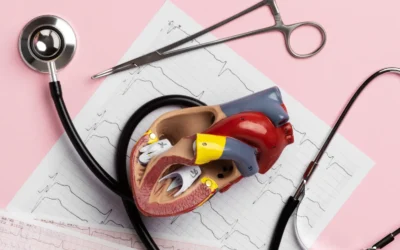Aortic aneurysms are conditions that occur when a portion of the aorta, the body’s primary highway for blood transportation, undergoes an expansion. Picture the aorta as the vital conduit that carries blood, the body’s fuel, from the heart, which acts as the engine, to every nook and cranny of the body.
However, when an aneurysm develops, it’s like the aorta turning into a stretchable balloon, susceptible to bursting. The consequences can be dire, leading to severe internal bleeding, which can ultimately be fatal.
To comprehend this better, consider the aorta as resembling a walking cane, comprising three distinct segments: the ascending aorta, the arch, and the descending aorta. Aneurysms can take root in any of these aortic sections.
If an aneurysm crops up in the abdominal region, the most common site, it earns the name “abdominal aortic aneurysm.” On the other hand, when it appears in the upper body, it’s labeled a “thoracic aortic aneurysm.”
Table of Contents
Causes of Aortic Aneurysm
Normally, the aorta’s wall is pliant, much like a balloon. It can expand or contract as required, depending on the flow of blood. However, this flexibility can wane due to a variety of factors, often linked to issues like high blood pressure, cholesterol levels, or simply the aging process. These factors can also weaken the aortic wall, causing it to bulge.
There are rarer triggers for aortic aneurysms as well, such as:
- Inherited structural problems with the aortic wall (e.g., Marfan syndrome)
- A bicuspid aortic valve, a condition where there are two leaflets instead of the usual three
- Syphilis
- Turner syndrome, a genetic disorder
- Inflammation of the aorta’s wall (aortic arteritis)
- Aortic dissection
- Trauma, like a severe chest injury that damages the aorta
Signs and Symptoms
In most cases, aortic aneurysms are stealthy, causing no noticeable symptoms. They often remain hidden until a doctor stumbles upon them during unrelated examinations or diagnostic tests, such as a CT scan or an echocardiogram.
Sometimes, though, there are hints of their presence. Symptoms are typically associated with the aneurysm pressing on neighboring structures:
- Compression of the windpipe (trachea) can lead to breathing difficulties, wheezing, coughing, or recurring pneumonia.
- When it interferes with the nerve controlling the vocal cord (laryngeal nerve), it might cause a hoarse voice.
- If it pushes on the esophagus, swallowing can become challenging.
Occasionally, patients may experience intermittent or persistent belly, chest, or back pain. These symptoms should raise alarm bells, as they could signal a rupture or dissection, both of which are grave medical emergencies.
Additionally, clots may develop due to abnormal blood flow within the aneurysm. These clots have the potential to travel to various parts of the body, including the brain (potentially causing a stroke) or to organs in the abdomen, arms, or legs.
Risk Factors
Numerous factors heighten the risk of developing an aortic aneurysm, its rupture, or dissection:
- High blood pressure: Elevated blood pressure places undue stress on the aortic wall.
- Smoking: Tobacco use is linked to a higher risk of aneurysm development.
- Family history: If close relatives have a history of aneurysms, your risk increases.
- Aneurysm characteristics: The size, type, and underlying cause of the aneurysm, along with your blood pressure, all play a role. Larger aneurysms are more prone to rupture. Specific types might have a higher rupture risk, depending on a range of factors.
When to Seek Medical Help
If you’re aware of having an aortic aneurysm or have a family history of such conditions, it’s crucial to act swiftly if you experience persistent, severe, or unusual chest, back, or abdominal pain. Such pain is often described as “tearing” and might shift from the chest to the midsection. Additional warning signs may include fainting and shortness of breath.
Patients with aortic aneurysms affecting the aortic arch or descending aorta could notice a worsening hoarseness of voice or swallowing difficulties, both due to pressure on the vocal cord nerve or esophagus. If these symptoms manifest, consulting a doctor is imperative.
Examinations and Tests
To detect an aortic aneurysm, healthcare providers may employ several examinations and tests. The U.S. Public Health Service recommends a one-time abdominal ultrasound for individuals over 65 (men) or 75 (women) with a history of smoking.
If symptoms are present, basic tests are usually conducted, such as blood pressure measurements, heart auscultation, chest X-rays, and electrocardiograms. However, these tests may not provide a comprehensive diagnosis.
For a more definitive assessment, a computed tomography (CT) scan of the chest, and possibly the abdomen and pelvis, is often necessary. It’s considered a safe procedure and typically involves minimal X-ray radiation exposure. A contrast agent is administered via a vein to enhance imaging.
A transthoracic echocardiogram (TTE), which employs an ultrasound placed on the chest, may be used to identify abdominal and early thoracic aortic aneurysms. Still, it may not capture certain sections of the aortic arch and further along the thoracic aorta. In some cases, a transesophageal echocardiogram (TEE) or a magnetic resonance imaging (MRI) scan could be recommended.
Treatment Options
The treatment plan for an aortic aneurysm depends on its location, size, causative factors, and growth rate. Options may include vigilant monitoring, surgical intervention, medications, and lifestyle modifications.
In cases requiring repair, two primary methods are considered:
- Open surgery: This involves an incision, often through the sternum, and stopping the heart temporarily with a heart-lung bypass machine. The extent of the procedure varies based on the location of the aneurysm.
- Stenting: Metal support stents are inserted through a blood vessel, eliminating the need for open surgery. This approach is suitable for abdominal and descending thoracic aortic aneurysms but may not work for ascending aortic aneurysms due to their unique structure.
Living With Aortic Aneurysm
Once an aortic aneurysm surfaces, it’s susceptible to growth. Regular check-ups with imaging tests are essential to monitor its progress. To slow the aneurysm’s growth and avert complications, patients must manage coexisting health problems and adopt a healthy lifestyle.
Prevention
Aortic aneurysms often result from atherosclerosis, the hardening of arteries due to plaque buildup. You can take control of modifiable risk factors to mitigate this risk. Monitoring crucial health markers, like blood pressure, cholesterol levels, and blood sugar, is crucial. Maintain a healthy diet, exercise regularly, quit smoking, limit alcohol intake, manage diabetes, and control cholesterol levels to keep your numbers in the healthy range and reduce the risk of atherosclerosis-related diseases.
Frequently Asked Questions
What risk factors are associated with the development of an aortic aneurysm?
Aortic aneurysms can be influenced by several risk factors. These include high blood pressure, smoking, a family history of aneurysms, certain genetic conditions, and atherosclerosis (hardening of the arteries).
What symptoms of aortic aneurysm should prompt me to seek medical attention?
Aortic aneurysms often don’t present noticeable symptoms. However, if you experience sudden, severe chest, back, or abdominal pain, or any unusual symptoms like difficulty swallowing, hoarseness, or persistent coughing, seek immediate medical attention.
When should an aortic aneurysm be repaired?
The decision to repair an aortic aneurysm depends on its size, location, and the patient’s overall health. Generally, repair is considered when the aneurysm reaches a certain size or if it causes symptoms.
Who should be screened for aortic aneurysms?
Screening for aortic aneurysms is recommended for individuals with a family history of aneurysms and those with certain genetic conditions that predispose them to these aneurysms. Screening may also be considered for older individuals with a history of smoking.
How often should my doctor order tests to monitor the size of my aortic aneurysm?
The frequency of monitoring tests depends on the size and growth rate of your aneurysm. Your doctor will establish a monitoring schedule tailored to your specific condition.
Are aortic aneurysms hereditary?
Yes, aortic aneurysms can be hereditary. If you have a family history of aneurysms, you may have an increased risk of developing one.
Are aortic aneurysms associated with other medical conditions?
Aortic aneurysms can be associated with certain medical conditions, such as Marfan syndrome, Ehlers-Danlos syndrome, and other genetic disorders. Atherosclerosis and high blood pressure can also contribute to their development.
If I need to have my aortic aneurysm repaired, should I undergo an open-repair or an endovascular repair?
The choice between open surgery and endovascular repair depends on the specific characteristics of your aneurysm, your overall health, and the expertise of your medical team. Your healthcare provider will discuss the best approach for your situation.
Should I be screened for aneurysms in other parts of my body?
Screening for aneurysms in other parts of the body may be considered, especially if you have risk factors or a family history of aneurysms. Talk to your healthcare provider about the need for additional screenings.
Are there any restrictions to my exercise program because of aortic aneurysm?
Your exercise program may need to be adjusted based on the size and location of your aortic aneurysm. It’s essential to consult with your healthcare provider for personalized guidance on exercise and physical activity to ensure your safety and well-being.





0 Comments